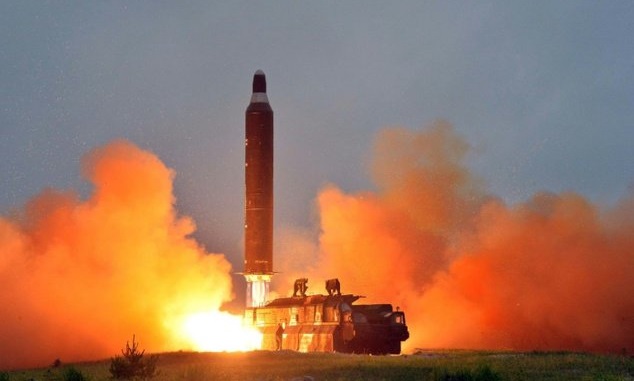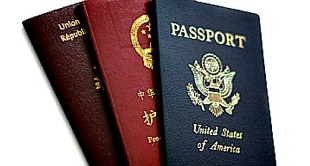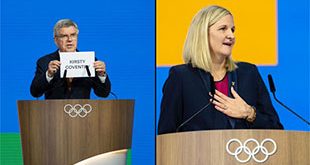
Seoul, South Korea | AFP | North Korea defended its right to take “tough counter-measures” in response to what it called US aggression, after firing a ballistic missile over Japan which sparked fear and fury in Tokyo Tuesday.
The test launch by the nuclear-armed nation was seen as a major escalation that triggered global alarm and an angry response from the Japanese government.
A visibly unsettled Prime Minister Shinzo Abe said it was an “unprecedented, serious and grave threat”, while the UN Security Council called an emergency meeting at Tokyo and Washington’s request.
But North Korean ambassador Han Tae-Song, addressing the UN Conference on Disarmament in Geneva, said his country had the right to react to ongoing US-South Korean military exercises.
“Now that the US has openly declared its hostile intention towards DPR (North) Korea by raising joint aggressive military exercises despite repeated warnings… my country has every reason to respond with tough counter-measures as an exercise of its rights to self-defence,” Han said, without mentioning the missile launch.
Washington, he said, would be responsible for “the catastrophic consequences” that may result from heightened tensions on the Korean peninsula.
The North always condemns the annual Ulchi Freedom Guardian exercise and other joint drills as a rehearsal for invasion, while Seoul and Washington say they are purely defensive.
Sirens blared out and text messages were fired off across northern Japan Tuesday warning people in the missile’s flight path to take cover.
Trains were delayed as passengers were urged to seek shelter inside stations.
“All lines are experiencing disruption,” said one sign on Sapporo’s metro system. “Reason: Ballistic missile launch.”
The last time a North Korean rocket overflew Japan was in 2009, when Pyongyang said it was a satellite launch. Washington, Seoul and Tokyo believed it was a clandestine test of an intercontinental ballistic missile (ICBM).
Pyongyang last month carried out two overt ICBM tests that appeared to bring much of the US mainland within reach for the first time.
At the time, US President Donald Trump issued an apocalyptic warning of raining “fire and fury” on the North, while Pyongyang threatened to fire a salvo of missiles towards the US territory of Guam.
South Korea said the latest missile was launched from Sunan near Pyongyang and flew around 2,700 kilometres (1,700 miles) at a maximum altitude of around 550 kilometres before landing in the sea. It was not aimed towards Guam.
Abe called the overflight an “outrageous act” that “greatly damages regional peace and security”.
– ‘Tipping point’ –
In a 40-minute telephone call with Trump, he said, they had agreed to “further strengthen pressure against North Korea”.
Robert Wood, US Permanent Representative to the Geneva conference, labelled it “another provocation” that was “a big concern”.
The EU denounced the launch as a “serious threat” to regional security
But China, the North’s key ally and main trading partner, urged restraint on all sides and said the US-South Korean military drills were partly to blame for heightening tension.
Foreign ministry spokeswoman Hua Chunying said the situation had reached a “tipping point” but warned that pressure and sanctions “cannot fundamentally solve the issue”.
She repeated Beijing’s call for the North to suspend missile tests in return for a halt to the military exercises.
Russia, which also has ties to Pyongyang, said it was “extremely worried” and hit out at a “tendency towards escalation”.
Any launch towards Guam would have to pass over Japan first and analysts said Tuesday’s overflight presents a major challenge to both Tokyo and Washington.
Before 2009, the only time it had traversed Japanese airspace was in 1998, in what it also claimed was a space launch. The US said it was a test of a Taepodong-1 missile.
– ‘Game of chicken’ –
Euan Graham, of the Lowy Institute in Australia, said a launch towards Guam would have been a “red line” for Washington, and instead Pyongyang selected a “half-way-house option”.
“The North Koreans in a way are being quite clever, by asking a difficult question of a key ally in the western Pacific (Japan) but at the same time not ratcheting up tensions to the point where the United States would seriously consider military measures,” he told AFP.
After Pyongyang appeared to postpone the Guam scheme, Trump told a rally in Phoenix that Kim was “starting to respect us”.
As a result, according to Cha Du-Hyeogn of the Asan Institute for Policy Studies in Seoul: “It looked like North Korea backed off from a game of chicken.
“But Pyongyang is showing that is not how it is,” he said. “That it is not a chicken, it has not backed off and that Washington is the one who is bluffing with no concrete plan.”
 The Independent Uganda: You get the Truth we Pay the Price
The Independent Uganda: You get the Truth we Pay the Price



